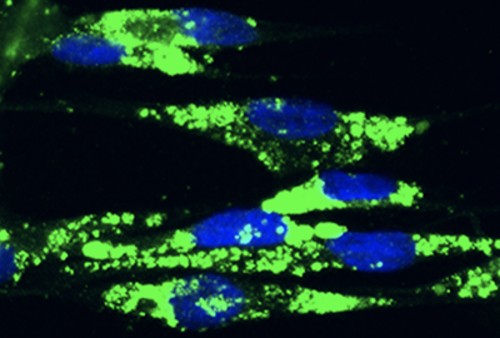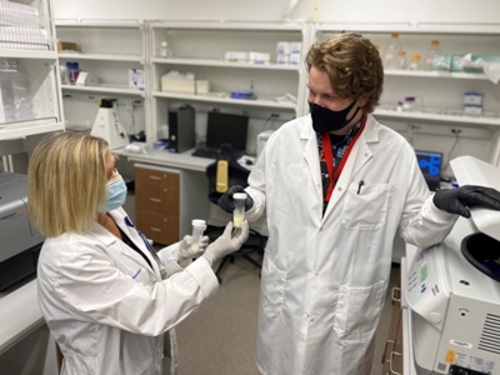Jay Vivian, PhD
Director, Rare Disease Model Research Program; Scientific Director Genetically Engineered Mouse Models Core, CMRI; Scientific Director, Transgenic and Gene Targeting Shared Resource, The University of Kansas Cancer Center; Associate Professor of Pediatrics, University of Missouri-Kansas City School of Medicine; Research Associate Professor of Pathology, University of Kansas School of Medicine
Full BiographyScott T. Younger, PhD
Director, Disease Gene Engineering; Associate Professor of Pediatrics, University of Missouri-Kansas City School of Medicine; Research Assistant Professor of Pediatrics, University of Kansas School of Medicine
Full BiographyTodd Bradley, PhD
Vice Chair, CMRI IBC; Director of Immunogenomics, Genomic Medicine Center; Associate Professor of Pediatrics, University of Missouri-Kansas City School of Medicine; Research Assistant Professor of Pediatrics, University of Kansas School of Medicine
Full Biography
The Genomic Medicine Center at Children’s Mercy provides clinical genomic services and conducts innovative genomic research, including the Genomic Answer for Kids (GA4K) program. GA4K is a first-of-its-kind pediatric data repository to collect genomic data and health information for children and their families. The team has produced more than 1,400 rare disease genomes through HiFi sequencing, using 5-base sequencing in genomic analysis. The genomic team has built a strong, translational foundation for researchers throughout Children's Mercy to build upon.
A voice for patients with the rarest of rare diseases
Jay Vivian, PhD, Director, Rare Disease Model Research Program and Associate Professor in the Division of Clinical Genetics and Department of Pediatrics, and his team focus on the development and analysis of cell models of rare pediatric disorders. He uses the genetic data the GA4K team has mapped and genome editing to engineer genetically modified, patient-specific cell models for therapeutic discovery. Dr. Vivian said, “We can leverage the power of the genomic center and move into the therapeutic realm.”

The GA4K team identified a Children's Mercy patient with Vici syndrome, a very rare autosomal recessive congenital disorder that impairs autophagy —the cellular process of recycling damaged cell materials. Children with the disorder experience profound developmental delay, seizures, hypotonia, immunodeficiency, cardiomyopathy, and loss of motor function. There are currently no treatment options, and median age of survival is 42 months.
Dr. Vivian launched a study to learn more about the disease with the hope of developing therapies to treat it. Using skin cell samples from the Children's Mercy patient and another child with the syndrome, his team generated patient-derived cell models. “These models are powerful tools to study diseases like Vici syndrome as well as try to develop therapies using drug screen experiments. We can essentially perform ‘clinical trials’ on the models,” said Dr. Vivian.
We can leverage the power of the genomic center and move into the therapeutic realm.
Patient-derived models hold great potential in understanding rare disease and to develop therapies. Given that the use of these models is a relatively new research focus at the CMRI, research and hospital leadership have invested a substantial amount of effort to develop the necessary oversight in the appropriate and ethical use of such models.
Dr. Vivian and his team are working to identify small molecules that enhance autophagy for use as a treatment. They are studying molecules from Food and Drug Administration (FDA) approved compounds and have some exciting leads. He reported that his lab’s short-term goal is to use cell models to test new therapies before moving to clinical trials in patients. Longer term, his team’s goal is to work with families affected by Vici syndrome and clinical colleagues to develop a clinical trial.
Dr. Vivian said, “It’s hard for voices to be heard for one disease like Vici syndrome with only approximately 100 diagnosed cases worldwide and 10 in the U.S., and for the families and patients to get research for such a rare disease.” However, he noted that the translational strategies used at Children's Mercy to not only identify rare diseases but study their characteristics and develop potential therapies via cell and animal models in the lab are foundational for a range of studies at Children's Mercy. “This is the foundation for future work,” he said. “These strategies can be broadly applied to other rare diseases, providing those affected with a voice in research.”
Scalable experimental technologies for faster development of patient-specific therapeutics
Scott Younger, PhD, Director, Disease Gene Engineering, Genomic Medicine Center, builds on the genetic data and biospecimens from the GA4K program to develop patient-derived cellular models for studying rare genetic diseases and engineering patient-specific interventions. During the past year, Dr. Younger has received awards from the National Institute of Child Health and Human Development (NICHHD), BioNexus KC, and the Katherine Berry Richardson Foundation to support his projects.
Dr. Younger’s platform has several advantages; it is less costly and time-consuming than traditional cellular model testing. It requires only a small number of patient cells to develop patient-derived organoids (three-dimensional cellular models), and multiple organoids can be processed at once in a single, 96-well plate instead of just one at a time as is common practice. This allows his team to generate patient-derived models and then test interventions on those models within one to two months – a much shorter timeframe than traditional methods. Dr. Younger said, “This platform is poised to dramatically accelerate the identification of disease-causing genetic variants and the development of personalized therapeutics for a subset of rare disease patients in the GA4K program.”

Dr. Younger’s team has applied this platform toward the preclinical development of a personalized therapeutic for patients with Duchenne muscular dystrophy (DMD), an inherited neuromuscular disease caused by mutations in the dystrophin gene. More specifically, his team designed antisense oligonucleotides (ASOs) that target variant-harboring dystrophin ribonucleic acid (RNA) transcripts and prevent a disease-causing variant from interfering with dystrophin protein expression. Results from this study have shown restoration of dystrophin protein expression is sufficient to reverse disease-associated phenotypes in patient-derived organoids.
With our platform, we will be able to simultaneously evaluate patient-specific responses to panels of medications in personalized cellular models. As opposed to a years-long trial-and-error process, we may be able to identify optimal therapeutic approaches in as little as eight weeks. That is a game changer.
Moving forward, Dr. Younger plans to apply this platform to evaluate therapeutic interventions for rare diseases associated with seizures, which are among the most common clinical presentations observed in GA4K. His team will generate patient-derived organoids to evaluate patient-specific responses to antiseizure medications. “There are more than two dozen FDA-approved antiseizure medications, but only a subset will work for any given patient,” said Dr. Younger. “How do you find the right drug? With our platform, we will be able to simultaneously evaluate patient-specific responses to panels of medications in personalized cellular models. As opposed to a years-long trial-and-error process, we may be able to identify optimal therapeutic approaches in as little as eight weeks. That is a game changer.”
Immunogenomics: Understanding infant immune systems and developing immunotherapies
Todd Bradley, PhD, Director, Immunogenomics, Genomic Medical Center, applies CMRI’s genomic technologies to immunology. When the immune system fails, children can experience life-threatening diseases, infections, and allergies.

Dr. Bradley’s lab focuses on understanding how antibody immune responses are regulated and then developing tools to engineer immunity. The team uses single-cell genomic technologies to study the immune system at high-resolution and depth, allowing them to dissect the molecular and cellular mechanisms that affect immune response to determine the impact of genetics on individual immunity.
One area of focus for Dr. Bradley’s lab is immunity and maternal-fetal health. As part of that research, Dr. Bradley uses genomic technology to better understand the role that breast milk plays in an infant’s immunity to disease and illnesses like respiratory syncytial virus (RSV). Human breast milk is not only nutritional but also contains antiviral and anti-inflammatory properties for babies, especially in colostrum — the milk that is produced in the first few days of breastfeeding. Dr. Bradley added that the states of breast milk change over time, depending on a variety of factors, including a mother’s diet, weight, chemical exposure or even the health of the infant. He said, “When a baby is sick, they signal their mom, and the mom then produces milk with the needed antiviral properties to help the baby recover.”
By using the single-cell genomic tools, his lab analyzed breast milk cells to identify the immunological dynamics of breast milk throughout the first few weeks postpartum. His team’s findings were recently published in Nature Communications Biology.
Step one is to immunize infants against RSV. Step two is treating a baby who is already sick and didn’t respond to the vaccine. And that is where we use genomic tools to engineer and design therapeutics.
Dr. Bradley is also interested in the impact viruses have on immunology and both the potential for vaccines as well as immunotherapies for viruses like RSV. RSV can cause serious illness, and infants who are hospitalized with it are more likely to develop asthma as well as have other health concerns in the future. Currently, therapeutics to treat RSV are limited and vaccines, although in development, aren’t yet available for infants. Because approximately 10% of the population doesn’t respond well to vaccines, Dr. Bradley points out that we need both vaccines and therapeutic options for viruses like RSV. “Step one is to immunize infants against RSV,” said Dr. Bradley. “Step two is treating a baby who is already sick and didn’t respond to the vaccine. And that is where we use genomic tools to engineer and design therapeutics.”
